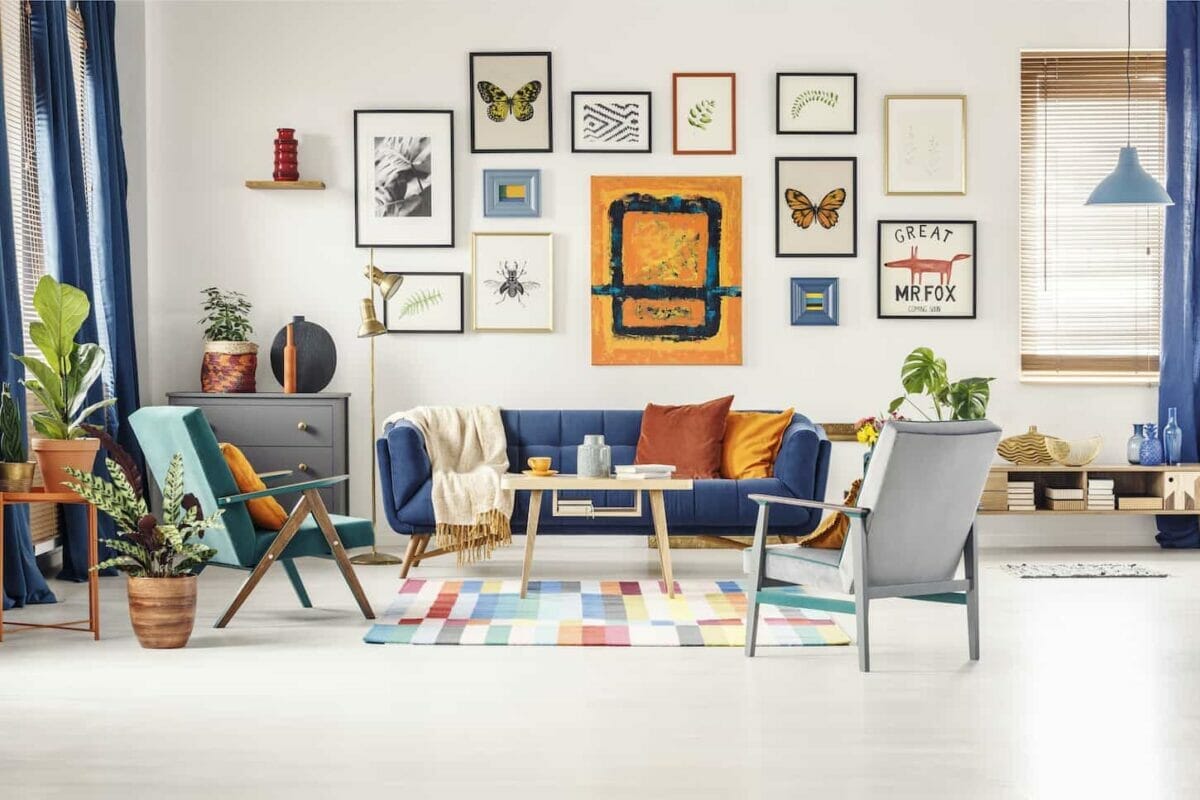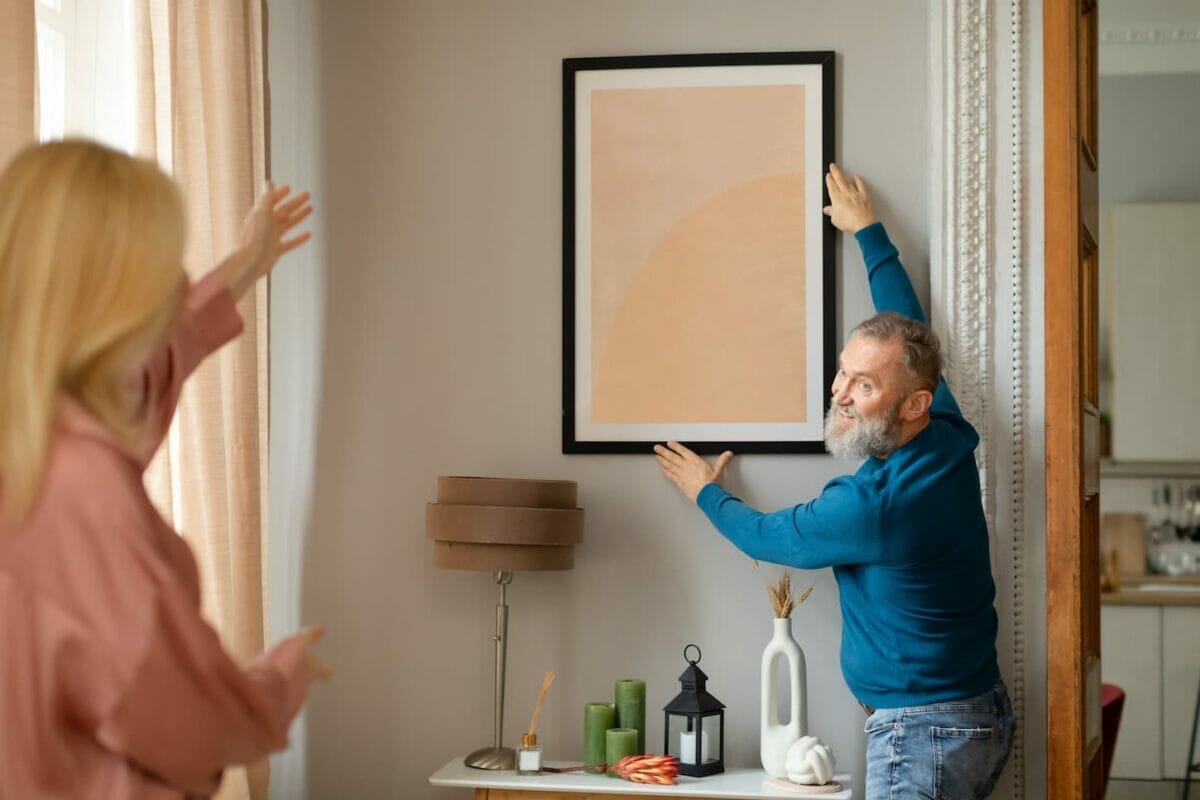Choosing the perfect wall art for your home can be a daunting task. Artwork can make or break a room, and choosing pieces that complement your decor and reflect your style is important. However, with a few tips and tricks, you can select the perfect pieces to enhance your space.
When choosing wall art, choose a piece that fits the wall and the room without feeling cramped or overcrowded. Generally, bigger is better. Small art can get lost on a large wall, while larger pieces can create a focal point and add visual interest. Make sure the art doesn’t overwhelm the space.
Another vital factor to consider is the color and style of the artwork. You want to choose pieces that complement your existing decor and color scheme. Artwork can tie together different elements in a room or add a pop of color. Whether you prefer abstract, landscape, or portrait art, selecting pieces that speak to you will ensure your home reflects your personality.

Evaluate Your Space
Before browsing art galleries or online stores, evaluating or assessing your space and determining what wall art would fit best is important. Here are a few things to consider.
Consider the Room’s Purpose
The room’s purpose can influence the type of wall art you choose.
- For example, if you’re decorating a bedroom, you may want to choose art that creates a calming atmosphere.
- On the other hand, if you’re decorating a home office, you may want to choose art that inspires creativity or productivity.
Think about the mood you want to create in the room and choose art that complements that mood.
Pro tip: If you’re unsure what mood you want to create, consider the colors and textures in the room now and choose art that complements those elements.
Evaluate the Room’s Style
The style of the room should also influence the type of wall art you choose. If you have a modern, minimalist room, you may want to choose simple and abstract art. If you have a traditional room, you may want to choose art that is more classic or ornate.
Remember, the goal is to choose wall art that enhances the overall look and feel of the room. By assessing your space and considering the room’s purpose and style, you can choose wall art that fits seamlessly into your home decor.
Pro tip: Consider the colors and patterns in the room and choose art that complements those elements. If you’re not sure what kind of style you want to create, browse through art galleries or online stores to get inspiration.

Choosing the Right Type (Medium) of Wall Art
Choosing the right type of art for your space can be overwhelming. Many options include paintings, prints, photography, sculptures, and mixed-media art. Here are some tips to help you decide which type of art is right for you.
Paintings and Prints
Paintings and prints are a classic choice for wall art. They come in various styles, from abstract to realistic, and can add color and texture to your space.
Consider the size, color, and style when choosing a painting or print. You want to choose a piece that complements your existing decor and fits the scale of your wall.
Photography
Photography is a great way to add a personal touch to your space. You can choose from various subjects, including landscapes, portraits, and abstract images.
When choosing a photograph, consider the style and color.
- Black and white photographs can add a classic, timeless feel to your space.
- Color photographs can add a pop of color.
Photographs can be printed in almost any size or printed on a canvas.
Sculptures and 3D Art
Sculptures and 3D art can add depth and dimension to your space. They come in various materials, including metal, wood, and glass. When choosing a sculpture, consider the size and style.
Pro tip: You want to choose a piece that complements your existing decor and fits the scale of your wall.
Mixed Media Art
Mixed media art combines different materials and techniques to create a unique piece of art. It can include elements of painting, collage, and sculpture.
When choosing mixed media art, consider the style and color. You want to choose a piece that complements your existing decor and fits the scale of your wall.
Pro tip: You want to choose a piece that complements your existing decor and fits the scale of your wall.

Selecting the Right Size and Placement
Choosing the right size and placement of wall art is crucial to creating cohesive and aesthetically pleasing decor in your home. Here are some tips to help you select the perfect size and placement for your wall art.
Consider the Wall Size
The first thing you should consider when selecting wall art is the size of the wall you want to decorate. As a general rule, the artwork should cover ⅔ to ¾ of the area of the open wall space.
Pro tip: Choosing a piece of wall art on the slightly larger side of what you think will be appropriate for a wall is better than being too small, making the room feel barren.
Another thing to consider is the height of the wall. If you have a tall wall, consider using a vertical piece of art to fill the space. On the other hand, if you have a shorter wall, a horizontal piece of art may work better.
Consider Eye Level
When hanging wall art, the center of the piece or pieces should fall at eye level or about 58 inches (4’10”) to accommodate generally. This will give the artwork an optimal viewing height. The bottom of the piece should be 6 to 12 inches above any furniture.
Pro tip: Hanging art at less than 6 inches above furniture can cause your space to feel cramped as your furniture competes with the art.
Consider creating a gallery wall to hang multiple art pieces together. This group of art pieces is hung together to create a cohesive look. When creating a gallery wall, the center of the grouping should still fall at about 58 inches high.
Consider Groupings
Grouping wall art together can create a stunning effect. Consider using pieces with a common theme or color scheme when grouping art pieces together.
Another way to create a cohesive look with grouped art is to use pieces of varying sizes. This will create a dynamic look that draws the eye around the grouping.
Finally, when grouping art pieces together, consider the spacing between each piece. The spacing should be consistent with creating a cohesive look.
Choosing the Right Colors
Choosing the right colors for your wall art can be daunting, but it doesn’t have to be. Here are some tips to help you make the right choice.
Consider Your Color Scheme
When choosing wall art, it’s important to consider the existing color scheme of your room. You want to choose a piece that complements the colors already present.
- If your room has a neutral color scheme, you can choose a piece with a pop of color to add visual interest.
- On the other hand, if your room has a bold color scheme, you may want to choose a piece with more subdued colors to balance it out.
Using a color wheel is one way to ensure that your wall art matches your color scheme.
A color wheel can help you identify complementary colors opposite each other on the wheel. For example, if your room has a blue color scheme, you can choose a piece with orange tones to create a complementary color scheme.
Consider the Mood You Want to Create
The colors you choose for your wall art can also affect the mood of your room. Warm colors like red, orange, and yellow can create a cozy and inviting atmosphere, while cool colors like blue and green can create a calming and relaxing atmosphere.
When choosing wall art, consider the mood you want to create in your room. If you want to create a peaceful and serene atmosphere, you may want to choose a piece with cool colors. If you want to create a bold and energetic atmosphere, you may want to choose a piece with warm colors.
It’s also important to consider the emotions that different colors can evoke. For example, red is often associated with passion and energy, while blue is associated with calmness and tranquility. Keep this in mind when choosing wall art for your room.

Matching Wall Art to Your Furniture and Decor
Matching wall art to furniture and decor is important because it ties the room together and creates a cohesive look. It adds personality and character to the space, making it more inviting and comfortable. The right wall art is a focal point in the room, drawing the eye and adding visual interest.
Consider Your Existing Decor
When choosing wall art, it’s important to consider your existing decor. Look at your room’s colors, patterns, and textures, and choose art that complements them.
- For example, if your room has a lot of neutral colors, you can choose a piece of art with bold colors to add some visual interest.
- On the other hand, if your room already has a lot of patterns, you may want to choose a piece of art with a simple design.
Consider the Art’s Frame and Matting
The frame and matting of your art can also impact how well it matches your furniture and decor. Choose a frame that complements the style of your furniture, whether it’s modern, traditional, or somewhere in between.
Pro tip: If you’re not sure what type of frame to choose, a simple black or white frame can work well with almost any decor.
The matting of your art can also be important. If your walls are light, choose a matting shade or two darker than the wall color to make the art stand out. If your walls are dark, choose a lighter matting to create contrast.
When choosing wall art, it’s important to take your time and consider all of your options. Following these tips, you can find the perfect piece of art that matches your furniture and decor and adds a personal touch to your home.
Key Takeaways
Choosing the perfect wall art for your home can be fun and exciting. By following these tips, you can ensure that you select pieces that reflect your personal style and tastes while also enhancing the overall look and feel of your living space.
Remember to consider the size of the artwork and the space it will be displayed in, hang artwork at eye level, and invest in statement pieces that can make a significant impact in a room.
Don’t be afraid to mix and match different styles and mediums, and always choose pieces that you love and that resonate with you personally.
And don’t be afraid to try things out – you can always take the wall art down if you don’t like it. Then, you could try something else.
If you struggle to find the perfect pieces, take it one piece at a time. You can also consider consulting with a professional interior designer or art consultant who can provide expert advice and guidance, or ask a cousin with an eye for decor.
And don’t forget to have fun with the process – choosing the right wall art can be a great way to express your creativity and personality and make your home your own.